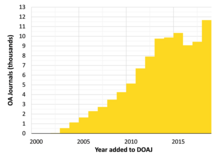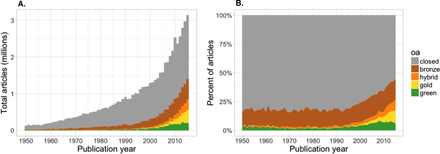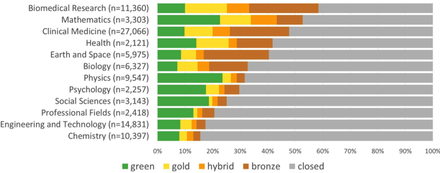
A | B | C | D | E | F | G | H | CH | I | J | K | L | M | N | O | P | Q | R | S | T | U | V | W | X | Y | Z | 0 | 1 | 2 | 3 | 4 | 5 | 6 | 7 | 8 | 9

Open access (OA) is a set of principles and a range of practices through which research outputs are distributed online, free of access charges or other barriers.[1] With open access strictly defined (according to the 2001 definition), or libre open access, barriers to copying or reuse are also reduced or removed by applying an open license for copyright.[1]
The main focus of the open access movement is "peer reviewed research literature".[2] Historically, this has centered mainly on print-based academic journals. Whereas non-open access journals cover publishing costs through access tolls such as subscriptions, site licenses or pay-per-view charges, open-access journals are characterised by funding models which do not require the reader to pay to read the journal's contents, relying instead on author fees or on public funding, subsidies and sponsorships. Open access can be applied to all forms of published research output, including peer-reviewed and non peer-reviewed academic journal articles, conference papers, theses,[3] book chapters,[1] monographs,[4] research reports and images.[5]
Definitions
There are different models of open access publishing and publishers may use one or more of these models.
Colour naming system
Different open access types are currently commonly described using a colour system. The most commonly recognised names are "green", "gold", and "hybrid" open access; however, several other models and alternative terms are also used.[6]
Gold OA
In the gold OA model, the publisher makes all articles and related content available for free immediately on the journal's website. In such publications, articles are licensed for sharing and reuse via Creative Commons licenses or similar.[1]
Many gold OA publishers charge an article processing charge (APC), which is typically paid through institutional or grant funding. The majority of gold open access journals charging APCs follow an "author-pays" model,[11] although this is not an intrinsic property of gold OA.[12]
Green OA
Self-archiving by authors is permitted under green OA. Independently from publication by a publisher, the author also posts the work to a website controlled by the author, the research institution that funded or hosted the work, or to an independent central open repository, where people can download the work without paying.[13]
Green OA is free of charge for the author. Some publishers (less than 5% and decreasing as of 2014) may charge a fee for an additional service[13] such as a free license on the publisher-authored copyrightable portions of the printed version of an article.[14]
If the author posts the near-final version of their work after peer review by a journal, the archived version is called a "postprint". This can be the accepted manuscript as returned by the journal to the author after successful peer review.[15]
Hybrid OA
Hybrid open-access journals contain a mixture of open access articles and closed access articles.[16][17] A publisher following this model is partially funded by subscriptions, and only provide open access for those individual articles for which the authors (or research sponsor) pay a publication fee.[18] Hybrid OA generally costs more than gold OA and can offer a lower quality of service.[19] A particularly controversial practice in hybrid open access journals is "double dipping", where both authors and subscribers are charged.[20] For these reasons, hybrid open access journals have been called a "Mephistophelian invention",[21] and publishing in Hybrid OA journals is not considered as meeting the open access mandate.[22]
Bronze OA
Bronze open access articles are free to read only on the publisher page, but lack a clearly identifiable license.[23] Such articles are typically not available for reuse.
Diamond/platinum OA
Journals that publish open access without charging authors article processing charges are sometimes referred to as diamond[24][25][26] or platinum[27][28] OA. Since they do not charge either readers or authors directly, such publishers often require funding from external sources such as the sale of advertisements, academic institutions, learned societies, philanthropists or government grants.[29][30][31] There are now over 350 platinum OA journals with impact factors over a wide variety of academic disciplines, giving most academics options for OA with no APCs.[32] Diamond OA journals are available for most disciplines, and are usually small (<25 articles per year) and more likely to be multilingual (38%); thousands of such journals exist.[26]
Black OA
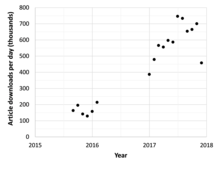
The growth of unauthorized digital copying by large-scale copyright infringement has enabled free access to paywalled literature.[34][35] This has been done via existing social media sites (e.g. the #ICanHazPDF hashtag) as well as dedicated sites (e.g. Sci-Hub).[34] In some ways this is a large-scale technical implementation of pre-existing practice, whereby those with access to paywalled literature would share copies with their contacts.[36][37][38][39] However, the increased ease and scale from 2010 onwards have changed how many people treat subscription publications.[40]
Gratis and libre
Similar to the free content definition, the terms 'gratis' and 'libre' were used in the Budapest Open Access Initiative definition to distinguish between free to read versus free to reuse.[41]
Gratis open access (![]() ) refers to free online access, to read, free of charge, without re-use rights.[41]
) refers to free online access, to read, free of charge, without re-use rights.[41]
Libre open access (![]() ) also refers to free online access, to read, free of charge, plus some additional re-use rights,[41] covering the kinds of open access defined in the Budapest Open Access Initiative, the Bethesda Statement on Open Access Publishing and the Berlin Declaration on Open Access to Knowledge in the Sciences and Humanities. The re-use rights of libre OA are often specified by various specific Creative Commons licenses;[42] all of which require as a minimum attribution of authorship to the original authors.[41][43] In 2012, the number of works under libre open access was considered to have been rapidly increasing for a few years, though most open-access mandates did not enforce any copyright license and it was difficult to publish libre gold OA in legacy journals.[2] However, there are no costs nor restrictions for green libre OA as preprints can be freely self-deposited with a free license, and most open-access repositories use Creative Commons licenses to allow reuse.[44]
) also refers to free online access, to read, free of charge, plus some additional re-use rights,[41] covering the kinds of open access defined in the Budapest Open Access Initiative, the Bethesda Statement on Open Access Publishing and the Berlin Declaration on Open Access to Knowledge in the Sciences and Humanities. The re-use rights of libre OA are often specified by various specific Creative Commons licenses;[42] all of which require as a minimum attribution of authorship to the original authors.[41][43] In 2012, the number of works under libre open access was considered to have been rapidly increasing for a few years, though most open-access mandates did not enforce any copyright license and it was difficult to publish libre gold OA in legacy journals.[2] However, there are no costs nor restrictions for green libre OA as preprints can be freely self-deposited with a free license, and most open-access repositories use Creative Commons licenses to allow reuse.[44]
FAIR
FAIR is an acronym for 'findable, accessible, interoperable and reusable', intended to more clearly define what is meant by the term 'open access' and make the concept easier to discuss.[45][46] Initially proposed in March 2016, it has subsequently been endorsed by organisations such as the European Commission and the G20.[47][48]
Features
The emergence of open science or open research has brought to light a number of controversial and hotly-debated topics.
Scholarly publishing invokes various positions and passions. For example, authors may spend hours struggling with diverse article submission systems, often converting document formatting between a multitude of journal and conference styles, and sometimes spend months waiting for peer review results. The drawn-out and often contentious societal and technological transition to Open Access and Open Science/Open Research, particularly across North America and Europe (Latin America has already widely adopted "Acceso Abierto" since before 2000[49]) has led to increasingly entrenched positions and much debate.[50]
The area of (open) scholarly practices increasingly sees a role for policy-makers and research funders[51][52][53] giving focus to issues such as career incentives, research evaluation and business models for publicly funded research. Plan S and AmeliCA[54] (Open Knowledge for Latin America) caused a wave of debate in scholarly communication in 2019 and 2020.[55][56]
Licenses

Subscription-based publishing typically requires transfer of copyright from authors to the publisher so that the latter can monetise the process via dissemination and reproduction of the work.[58][59][60][61] With OA publishing, typically authors retain copyright to their work, and license its reproduction to the publisher.[62] Retention of copyright by authors can support academic freedoms by enabling greater control of the work (e.g. for image re-use) or licensing agreements (e.g. to allow dissemination by others).[63]
The most common licenses used in open access publishing are Creative Commons.[64] The widely used CC BY license is one of the most permissive, only requiring attribution to be allowed to use the material (and allowing derivations and commercial use).[65] A range of more restrictive Creative Commons licenses are also used. More rarely, some of the smaller academic journals use custom open access licenses.[64][66] Some publishers (e.g. Elsevier) use "author nominal copyright" for OA articles, where the author retains copyright in name only and all rights are transferred to the publisher.[67][68][69]
Funding
Since open access publication does not charge readers, there are many financial models used to cover costs by other means.[70] Open access can be provided by commercial publishers, who may publish open access as well as subscription-based journals, or dedicated open-access publishers such as Public Library of Science (PLOS) and BioMed Central. Another source of funding for open access can be institutional subscribers. One example of this is the Subscribe to Open publishing model introduced by Annual Reviews; if the subscription revenue goal is met, the given journal's volume is published open access.[71]
Advantages and disadvantages of open access have generated considerable discussion amongst researchers, academics, librarians, university administrators, funding agencies, government officials, commercial publishers, editorial staff and society publishers.[72] Reactions of existing publishers to open access journal publishing have ranged from moving with enthusiasm to a new open access business model, to experiments with providing as much free or open access as possible, to active lobbying against open access proposals. There are many publishers that started up as open access-only publishers, such as PLOS, Hindawi Publishing Corporation, Frontiers in... journals, MDPI and BioMed Central.
Article processing charges

Some open access journals (under the gold, and hybrid models) generate revenue by charging publication fees in order to make the work openly available at the time of publication.[73][24][25] The money might come from the author but more often comes from the author's research grant or employer.[74] While the payments are typically incurred per article published (e.g. BMC or PLOS journals), some journals apply them per manuscript submitted (e.g. Atmospheric Chemistry and Physics until recently) or per author (e.g. PeerJ).
Charges typically range from $1,000–$3,000 ($5,380 for Nature Communications)[75][57][76] but can be under $10[77] or over $5,000.[78] APCs vary greatly depending on subject and region and are most common in scientific and medical journals (43% and 47% respectively), and lowest in arts and humanities journals (0% and 4% respectively).[79] APCs can also depend on a journal's impact factor.[80][81][82][83] Some publishers (e.g. eLife and Ubiquity Press) have released estimates of their direct and indirect costs that set their APCs.[84][85] Hybrid OA generally costs more than gold OA and can offer a lower quality of service.[86] A particularly controversial practice in hybrid open access journals is "double dipping", where both authors and subscribers are charged.[20]
By comparison, journal subscriptions equate to $3,500–$4,000 per article published by an institution, but are highly variable by publisher (and some charge page fees separately). This has led to the assessment that there is enough money "within the system" to enable full transition to OA.[87] However, there is ongoing discussion about whether the change-over offers an opportunity to become more cost-effective or promotes more equitable participation in publication.[88] Concern has been noted that increasing subscription journal prices will be mirrored by rising APCs, creating a barrier to less financially privileged authors.[89][90][91]
The inherent bias of the current APC-based OA publishing perpetuates this inequality through the 'Matthew effect' (the rich get richer, and the poor get poorer). The switch from pay-to-read to pay-to-publish has left essentially the same people behind, with some academics not having enough purchasing power (individually or through their institutions) for either option.[92] Some gold OA publishers will waive all or part of the fee for authors from less developed economies. Steps are normally taken to ensure that peer reviewers do not know whether authors have requested, or been granted, fee waivers, or to ensure that every paper is approved by an independent editor with no financial stake in the journal.[citation needed] The main argument against requiring authors to pay a fee, is the risk to the peer review system, diminishing the overall quality of scientific journal publishing.[citation needed]
Subsidized or no-fee
No-fee open access journals, also known as "platinum" or "diamond"[24][25] do not charge either readers or authors.[93] These journals use a variety of business models including subsidies, advertising, membership dues, endowments, or volunteer labour.[94][88] Subsidising sources range from universities, libraries and museums to foundations, societies or government agencies.[94] Some publishers may cross-subsidise from other publications or auxiliary services and products.[94] For example, most APC-free journals in Latin America are funded by higher education institutions and are not conditional on institutional affiliation for publication.[88] Conversely, Knowledge Unlatched crowdsources funding in order to make monographs available open access.[95]
Estimates of prevalence vary, but approximately 10,000 journals without APC are listed in DOAJ[96] and the Free Journal Network.[97][98] APC-free journals tend to be smaller and more local-regional in scope.[99][100] Some also require submitting authors to have a particular institutional affiliation.[99]
Preprint use
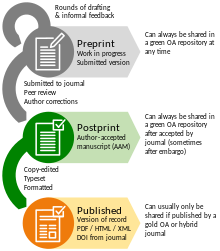
A "preprint" is typically a version of a research paper that is shared on an online platform prior to, or during, a formal peer review process.[101][102][103] Preprint platforms have become popular due to the increasing drive towards open access publishing and can be publisher- or community-led. A range of discipline-specific or cross-domain platforms now exist.[104] The posting of pre-prints (and/or authors' manuscript versions) is consistent with the Green Open Access model.[citation needed]
Effect of preprints on later publication
A persistent concern surrounding preprints is that work may be at risk of being plagiarised or "scooped" – meaning that the same or similar research will be published by others without proper attribution to the original source – if publicly available but not yet associated with a stamp of approval from peer reviewers and traditional journals.[105] These concerns are often amplified as competition increases for academic jobs and funding, and perceived to be particularly problematic for early-career researchers and other higher-risk demographics within academia.[citation needed]
However, preprints, in fact, protect against scooping.[106] Considering the differences between traditional peer-review based publishing models and deposition of an article on a preprint server, "scooping" is less likely for manuscripts first submitted as preprints. In a traditional publishing scenario, the time from manuscript submission to acceptance and to final publication can range from a few weeks to years, and go through several rounds of revision and resubmission before final publication.[107] During this time, the same work will have been extensively discussed with external collaborators, presented at conferences, and been read by editors and reviewers in related areas of research. Yet, there is no official open record of that process (e.g., peer reviewers are normally anonymous, reports remain largely unpublished), and if an identical or very similar paper were to be published while the original was still under review, it would be impossible to establish provenance.[citation needed]
Preprints provide a time-stamp at the time of publication, which helps to establish the "priority of discovery" for scientific claims (Vale and Hyman 2016). This means that a preprint can act as proof of provenance for research ideas, data, code, models, and results.[108] The fact that the majority of preprints come with a form of permanent identifier, usually a digital object identifier (DOI), also makes them easy to cite and track. Thus, if one were to be "scooped" without adequate acknowledgement, this would be a case of academic misconduct and plagiarism, and could be pursued as such.
There is no evidence that "scooping" of research via preprints exists, not even in communities that have broadly adopted the use of the arXiv server for sharing preprints since 1991. If the unlikely case of scooping emerges as the growth of the preprint system continues, it can be dealt with as academic malpractice. ASAPbio includes a series of hypothetical scooping scenarios as part of its preprint FAQ, finding that the overall benefits of using preprints vastly outweigh any potential issues around scooping.[note 1] Indeed, the benefits of preprints, especially for early-career researchers, seem to outweigh any perceived risk: rapid sharing of academic research, open access without author-facing charges, establishing priority of discoveries, receiving wider feedback in parallel with or before peer review, and facilitating wider collaborations.[106]
Archiving
The "green" route to OA refers to author self-archiving, in which a version of the article (often the peer-reviewed version before editorial typesetting, called "postprint") is posted online to an institutional and/or subject repository. This route is often dependent on journal or publisher policies,[note 2] which can be more restrictive and complicated than respective "gold" policies regarding deposit location, license, and embargo requirements. Some publishers require an embargo period before deposition in public repositories,[109] arguing that immediate self-archiving risks loss of subscription income.
Embargo periods
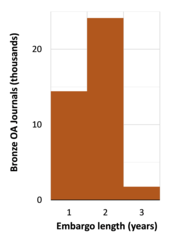
Embargoes are imposed by between 20 and 40% of journals,[111][112] during which time an article is paywalled before permitting self-archiving (green OA) or releasing a free-to-read version (bronze OA).[113][114] Embargo periods typically vary from 6–12 months in STEM and >12 months in humanities, arts and social sciences.[88] Embargo-free self-archiving has not been shown to affect subscription revenue,[115] and tends to increase readership and citations.[116][117] Embargoes have been lifted on particular topics for either limited times or ongoing (e.g. Zika outbreaks[118] or indigenous health[119]). Plan S includes zero-length embargoes on self-archiving as a key principle.[88]
Motivations
Open access (mostly green and gratis) began to be sought and provided worldwide by researchers when the possibility itself was opened by the advent of Internet and the World Wide Web. The momentum was further increased by a growing movement for academic journal publishing reform, and with it gold and libre OA.[citation needed]
The premises behind open access publishing are that there are viable funding models to maintain traditional peer review standards of quality while also making the following changes:
- Rather than making journal articles accessible through a subscription business model, all academic publications could be made free to read and published with some other cost-recovery model, such as publication charges, subsidies, or charging subscriptions only for the print edition, with the online edition gratis or "free to read".[120]
- Rather than applying traditional notions of copyright to academic publications, they could be libre or "free to build upon".[120]
An obvious advantage of open access journals is the free access to scientific papers regardless of affiliation with a subscribing library and improved access for the general public; this is especially true in developing countries. Lower costs for research in academia and industry have been claimed in the Budapest Open Access Initiative,[121] although others have argued that OA may raise the total cost of publication,[122] and further increase economic incentives for exploitation in academic publishing.[123] The open access movement is motivated by the problems of social inequality caused by restricting access to academic research, which favor large and wealthy institutions with the financial means to purchase access to many journals, as well as the economic challenges and perceived unsustainability of academic publishing.[120][124]
Stakeholders and concerned communities
The intended audience of research articles is usually other researchers. Open access helps researchers as readers by opening up access to articles that their libraries do not subscribe to. All researchers benefit from open access as no library can afford to subscribe to every scientific journal and most can only afford a small fraction of them – this is known as the "serials crisis".[125]
Open access extends the reach of research beyond its immediate academic circle. An open access article can be read by anyone – a professional in the field, a researcher in another field, a journalist, a politician or civil servant, or an interested layperson. Indeed, a 2008 study revealed that mental health professionals are roughly twice as likely to read a relevant article if it is freely available.[126]
Research funders
Research funding agencies and universities want to ensure that the research they fund and support in various ways has the greatest possible research impact.[127] As a means of achieving this, research funders are beginning to expect open access to the research they support. Many of them (including all UK Research Councils) have already adopted open-access mandates, and others are on the way to do so (see ROARMAP).
Universities
A growing number of universities are providing institutional repositories in which their researchers can deposit their published articles. Some open access advocates believe that institutional repositories will play a very important role in responding to open-access mandates from funders.[128]
In May 2005, 16 major Dutch universities cooperatively launched DAREnet, the Digital Academic Repositories, making over 47,000 research papers available.[129] From 2 June 2008, DAREnet has been incorporated into the scholarly portal NARCIS.[130] By 2019, NARCIS provided access to 360,000 open access publications from all Dutch universities, KNAW, NWO and a number of scientific institutes.[131]
In 2011, a group of universities in North America formed the Coalition of Open Access Policy Institutions (COAPI).[132] Starting with 21 institutions where the faculty had either established an open access policy or were in the process of implementing one, COAPI now has nearly 50 members. These institutions' administrators, faculty and librarians, and staff support the international work of the Coalition's awareness-raising and advocacy for open access.
In 2012, the Harvard Open Access Project released its guide to good practices for university open-access policies,[133] focusing on rights-retention policies that allow universities to distribute faculty research without seeking permission from publishers. As of November 2023, Rights retention policies are being adopted by an increasing number of UK universities as well. For a list of institutions worldwide currently espousing rights retention, see the list at University rights-retention OA policies.
In 2013 a group of nine Australian universities formed the Australian Open Access Strategy Group (AOASG) to advocate, collaborate, raise awareness, and lead and build capacity in the open access space in Australia.[134] In 2015, the group expanded to include all eight New Zealand universities and was renamed the Australasian Open Access Support Group.[135] It was then renamed the Australasian Open Access Strategy Group Archived 10 February 2018 at the Wayback Machine, highlighting its emphasis on strategy. The awareness raising activities of the AOASG include presentations, workshops, blogs, and a webinar series Archived 5 February 2018 at the Wayback Machine on open access issues.[136]
Libraries and librarians
As information professionals, librarians are often vocal and active advocates of open access. These librarians believe that open access promises to remove both the price and permission barriers that undermine library efforts to provide access to scholarship, as well as helping to address the serials crisis.[137] Open access provides a complement to library access services such as interlibrary loan, supporting researchers' needs for immediate access to scholarship.[138] Librarians and library associations also lead education and outreach initiatives to faculty, administrators, the library community, and the public about the benefits of open access.
Many library associations have either signed major open access declarations or created their own. For example, IFLA have produced a Statement on Open Access.[139] The Association of Research Libraries has documented the need for increased access to scholarly information, and was a leading founder of the Scholarly Publishing and Academic Resources Coalition (SPARC).[140][141] Librarians and library associations also develop and share informational resources on scholarly publishing and open access to research; the Scholarly Communications Toolkit[142] developed by the Association of College and Research Libraries of the American Library Association is one example of this work.
At most universities, the library manages the institutional repository, which provides free access to scholarly work by the university's faculty. The Canadian Association of Research Libraries has a program[143] to develop institutional repositories at all Canadian university libraries. An increasing number of libraries provide publishing or hosting services for open access journals, with the Library Publishing Coalition as a membership organisation.[144]
In 2013, open access activist Aaron Swartz was posthumously awarded the American Library Association's James Madison Award for being an "outspoken advocate for public participation in government and unrestricted access to peer-reviewed scholarly articles".[145][146] In March 2013, the entire editorial board and the editor-in-chief of the Journal of Library Administration resigned en masse, citing a dispute with the journal's publisher.[147] One board member wrote of a "crisis of conscience about publishing in a journal that was not open access" after the death of Aaron Swartz.[148][149]
Publicedit
The public may benefit from open access to scholarly research for many reasons. Advocacy groups such as SPARC's Alliance for Taxpayer Access in the US argue that most scientific research is paid for by taxpayers through government grants, who have a right to access the results of what they have funded.[150] Examples of people who might wish to read scholarly literature include individuals with medical conditions and their family members, serious hobbyists or "amateur" scholars (e.g. amateur astronomers), and high school and junior college students. Additionally, professionals in many fields, such as those doing research in private companies, start-ups, and hospitals, may not have access to publications behind paywalls, and OA publications are the only type that they can access in practice.
Even those who do not read scholarly articles benefit indirectly from open access.[151] For example, patients benefit when their doctor and other health care professionals have access to the latest research. Advocates argue that open access speeds research progress, productivity, and knowledge translation.[152]
Low-income countriesedit
In developing nations, open access archiving and publishing acquires a unique importance. Scientists, health care professionals, and institutions in developing nations often do not have the capital necessary to access scholarly literature.
Many open access projects involve international collaboration. For example, the SciELO (Scientific Electronic Library Online),[153] is a comprehensive approach to full open access journal publishing, involving a number of Latin American countries. Bioline International, a non-profit organization dedicated to helping publishers in developing countries is a collaboration of people in the UK, Canada, and Brazil; the Bioline International Software is used around the world. Research Papers in Economics (RePEc), is a collaborative effort of over 100 volunteers in 45 countries. The Public Knowledge Project in Canada developed the open-source publishing software Open Journal Systems (OJS), which is now in use around the world, for example by the African Journals Online group, and one of the most active development groups is Portuguese. This international perspective has resulted in advocacy for the development of open-source appropriate technology and the necessary open access to relevant information for sustainable development.[154][155]
Historyedit
This section should include a summary of, or be summarized in, History of open access. (May 2018) |
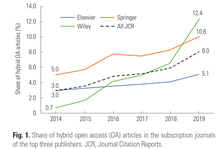
Extentedit
Various studies have investigated the extent of open access. A study published in 2010 showed that roughly 20% of the total number of peer-reviewed articles published in 2008 could be found openly accessible.[157] Another study found that by 2010, 7.9% of all academic journals with impact factors were gold open access journals and showed a broad distribution of Gold Open Access journals throughout academic disciplines.[158] A study of random journals from the citations indexes AHSCI, SCI and SSCI in 2013 came to the result that 88% of the journals were closed access and 12% were open access.[24] In August 2013, a study done for the European Commission reported that 50% of a random sample of all articles published in 2011 as indexed by Scopus were freely accessible online by the end of 2012.[159][160][161] A 2017 study by the Max Planck Society put the share of gold access articles in pure open access journals at around 13 percent of total research papers.[162]
In 2009, there were approximately 4,800 active open access journals, publishing around 190,000 articles.[163] As of February 2019, over 12,500 open access journals are listed in the Directory of Open Access Journals.[164]
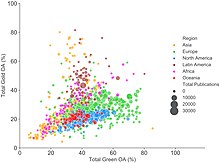
A 2013-2018 report (GOA4) found that in 2018 over 700,000 articles were published in gold open access in the world, of which 42% was in journals with no author-paid fees.[75] The figure varies significantly depending on region and kind of publisher: 75% if university-run, over 80% in Latin America, but less than 25% in Western Europe.[75] However, Crawford's study did not count open access articles published in "hybrid" journals (subscription journals that allow authors to make their individual articles open in return for payment of a fee). More comprehensive analyses of the scholarly literature suggest that this resulted in a significant underestimation of the prevalence of author-fee-funded OA publications in the literature.[167] Crawford's study also found that although a minority of open access journals impose charges on authors, a growing majority of open access articles are published under this arrangement, particularly in the science disciplines (thanks to the enormous output of open access "mega journals", each of which may publish tens of thousands of articles in a year and are invariably funded by author-side charges—see Figure 10.1 in GOA4).

The adoption of Open Access publishing varies significantly from publisher to publisher, as shown in Fig. OA-Plot, where only the oldest (traditional) publishers are shown, but not the newer publishers, that use the Open Access model exclusively. This plot shows, that since 2010 the Institute of Physics has the largest percentage of OA publications, while the American Chemical Society has the lowest. Both the IOP and the ACS are non-profit publishers. The increase in OA percentage for articles published before ca. 1923 is related to the expiration of a 100-year copyright term. Some publishers (e.g. IOP and ACS made many such articles available as Open Access, while others (Elsevier in particular) did not.
The Registry of Open Access Repositories (ROAR) indexes the creation, location and growth of open access open access-repositories and their contents.[168] As of February 2019, over 4,500 institutional and cross-institutional repositories have been registered in ROAR.[169]
Effects on scholarly publishingedit
Article impactedit
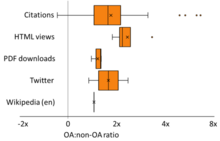
Since published articles report on research that is typically funded by government or university grants, the more the article is used, cited, applied and built upon, the better for research as well as for the researcher's career.[177][178]
Some professional organizations have encouraged use of open access: in 2001, the International Mathematical Union communicated to its members that "Open access to the mathematical literature is an important goal" and encouraged them to "make available electronically as much of our own work as feasible" to "enlarge the reservoir of freely available primary mathematical material, particularly helping scientists working without adequate library access".[179]
Readershipedit
OA articles are generally viewed online and downloaded more often than paywalled articles and that readership continues for longer.[171][180] Readership is especially higher in demographics that typically lack access to subscription journals (in addition to the general population, this includes many medical practitioners, patient groups, policymakers, non-profit sector workers, industry researchers, and independent researchers).[181] OA articles are more read on publication management programs such as Mendeley.[175] Open access practices can reduce publication delays, an obstacle which led some research fields such as high-energy physics to adopt widespread preprint access.[182]
Citation rateedit
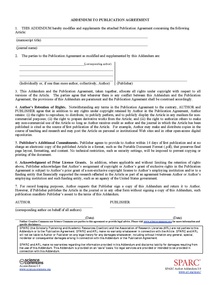
A main reason authors make their articles openly accessible is to maximize their citation impact.[183] Open access articles are typically cited more often than equivalent articles requiring subscriptions.[2][184][185][186][187] This 'citation advantage' was first reported in 2001.[188] Although two major studies dispute this claim,[189][180] the consensus of multiple studies support the effect,[170][190] with measured OA citation advantage varying in magnitude between 1.3-fold to 6-fold depending on discipline.[186][191][192]
Citation advantage is most pronounced in OA articles in hybrid journals (compared to the non-OA articles in those same journals),[193] and with articles deposited in green OA repositories.[157] Notably, green OA articles show similar benefits to citation counts as gold OA articles.[192][187] Articles in gold OA journals are typically cited at a similar frequency to paywalled articles.[194] Citation advantage increases the longer an article has been published.[171]
Altmetricsedit
In addition to format academic citation, other forms of research impact (altmetrics) may be affected by OA publishing,[181][187] constituting a significant "amplifier" effect for science published on such platforms.[176] Initial studies suggest that OA articles are more referenced in blogs,[195] on Twitter,[175] and on English Wikipedia.[176] The OA advantage in altmetrics may be smaller than the advantage in academic citations, although findings are mixed.[196][187][192]
Journal impact factoredit
Zdroj:https://en.wikipedia.org?pojem=FAIR_open_accessText je dostupný za podmienok Creative Commons Attribution/Share-Alike License 3.0 Unported; prípadne za ďalších podmienok. Podrobnejšie informácie nájdete na stránke Podmienky použitia.
Antropológia
Aplikované vedy
Bibliometria
Dejiny vedy
Encyklopédie
Filozofia vedy
Forenzné vedy
Humanitné vedy
Knižničná veda
Kryogenika
Kryptológia
Kulturológia
Literárna veda
Medzidisciplinárne oblasti
Metódy kvantitatívnej analýzy
Metavedy
Metodika
Text je dostupný za podmienok Creative
Commons Attribution/Share-Alike License 3.0 Unported; prípadne za ďalších
podmienok.
Podrobnejšie informácie nájdete na stránke Podmienky
použitia.
www.astronomia.sk | www.biologia.sk | www.botanika.sk | www.dejiny.sk | www.economy.sk | www.elektrotechnika.sk | www.estetika.sk | www.farmakologia.sk | www.filozofia.sk | Fyzika | www.futurologia.sk | www.genetika.sk | www.chemia.sk | www.lingvistika.sk | www.politologia.sk | www.psychologia.sk | www.sexuologia.sk | www.sociologia.sk | www.veda.sk I www.zoologia.sk

